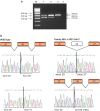CASK mutations are frequent in males and cause X-linked nystagmus and variable XLMR phenotypes
- PMID: 20029458
- PMCID: PMC2987321
- DOI: 10.1038/ejhg.2009.220
CASK mutations are frequent in males and cause X-linked nystagmus and variable XLMR phenotypes
Erratum in
- Eur J Hum Genet. 2010 May;18(5):552
Abstract
Mutations of the calcium/calmodulin-dependent serine protein kinase (CASK) gene have recently been associated with X-linked mental retardation (XLMR) with microcephaly, optic atrophy and brainstem and cerebellar hypoplasia, as well as with an X-linked syndrome having some FG-like features. Our group has recently identified four male probands from 358 probable XLMR families with missense mutations (p.Y268H, p.P396S, p.D710G and p.W919R) in the CASK gene. Congenital nystagmus, a rare and striking feature, was present in two of these families. We screened a further 45 probands with either nystagmus or microcephaly and mental retardation (MR), and identified two further mutations, a missense mutation (p.Y728C) and a splice mutation (c.2521-2A>T) in two small families with nystagmus and MR. Detailed clinical examinations of all six families, including an ophthalmological review in four families, were undertaken to further characterise the phenotype. We report on the clinical features of 24 individuals, mostly male, from six families with CASK mutations. The phenotype was variable, ranging from non-syndromic mild MR to severe MR associated with microcephaly and dysmorphic facial features. Carrier females were variably affected. Congenital nystagmus was found in members of four of the families. Our findings reinforce the CASK gene as a relatively frequent cause of XLMR in females and males. We further define the phenotypic spectrum and demonstrate that affected males with missense mutations or in-frame deletions in CASK are frequently associated with congenital nystagmus and XLMR, a striking feature not previously reported.
Figures






Similar articles
-
A de novo splice site mutation in CASK causes FG syndrome-4 and congenital nystagmus.Am J Med Genet A. 2017 Mar;173(3):611-617. doi: 10.1002/ajmg.a.38069. Epub 2017 Jan 31. Am J Med Genet A. 2017. PMID: 28139025
-
Mutations of CASK cause an X-linked brain malformation phenotype with microcephaly and hypoplasia of the brainstem and cerebellum.Nat Genet. 2008 Sep;40(9):1065-7. doi: 10.1038/ng.194. Nat Genet. 2008. PMID: 19165920
-
Phenotypic and molecular insights into CASK-related disorders in males.Orphanet J Rare Dis. 2015 Apr 12;10:44. doi: 10.1186/s13023-015-0256-3. Orphanet J Rare Dis. 2015. PMID: 25886057 Free PMC article.
-
X-linked mental retardation: further lumping, splitting and emerging phenotypes.Clin Genet. 2005 Jun;67(6):451-67. doi: 10.1111/j.1399-0004.2005.00434.x. Clin Genet. 2005. PMID: 15857409 Review.
-
Diverse Clinical Phenotypes of CASK-Related Disorders and Multiple Functional Domains of CASK Protein.Genes (Basel). 2023 Aug 20;14(8):1656. doi: 10.3390/genes14081656. Genes (Basel). 2023. PMID: 37628707 Free PMC article. Review.
Cited by
-
Analyses of the autism-associated neuroligin-3 R451C mutation in human neurons reveal a gain-of-function synaptic mechanism.Mol Psychiatry. 2024 Jun;29(6):1620-1635. doi: 10.1038/s41380-022-01834-x. Epub 2022 Oct 24. Mol Psychiatry. 2024. PMID: 36280753 Free PMC article.
-
Sumoylation in Synaptic Function and Dysfunction.Front Synaptic Neurosci. 2016 Apr 28;8:9. doi: 10.3389/fnsyn.2016.00009. eCollection 2016. Front Synaptic Neurosci. 2016. PMID: 27199730 Free PMC article. Review.
-
Emerging evidence implicating a role for neurexins in neurodegenerative and neuropsychiatric disorders.Open Biol. 2021 Oct;11(10):210091. doi: 10.1098/rsob.210091. Epub 2021 Oct 6. Open Biol. 2021. PMID: 34610269 Free PMC article. Review.
-
An N-terminal heterozygous missense CASK mutation is associated with microcephaly and bilateral retinal dystrophy plus optic nerve atrophy.Am J Med Genet A. 2019 Jan;179(1):94-103. doi: 10.1002/ajmg.a.60687. Epub 2018 Dec 14. Am J Med Genet A. 2019. PMID: 30549415 Free PMC article.
-
Synaptic Neurexin Complexes: A Molecular Code for the Logic of Neural Circuits.Cell. 2017 Nov 2;171(4):745-769. doi: 10.1016/j.cell.2017.10.024. Cell. 2017. PMID: 29100073 Free PMC article. Review.
References
-
- Dimitratos SD, Stathakis DG, Nelson CA, Woods DF, Bryant PJ. The location of human CASK at Xp11.4 identifies this gene as a candidate for X-linked optic atrophy. Genomics. 1998;51:308–309. - PubMed
-
- Froyen G, Van Esch H, Bauters M, et al. Detection of genomic copy number changes in patients with idiopathic mental retardation by high-resolution X-array-CGH: important role for increased gene dosage of XLMR genes. Hum Mutat. 2007;28:1034–1042. - PubMed
-
- Hayashi S, Mizuno S, Migita O, et al. The CASK gene harbored in a deletion detected by array-CGH as a potential candidate for a gene causative of X-linked dominant mental retardation. Am J Med Genet A. 2008;146A:2145–2151. - PubMed
-
- Najm J, Horn D, Wimplinger I, et al. Mutations of CASK cause an X-linked brain malformation phenotype with microcephaly and hypoplasia of the brainstem and cerebellum. Nat Genet. 2008;40:1065–1067. - PubMed
Publication types
MeSH terms
Substances
Grants and funding
LinkOut - more resources
Full Text Sources
Medical

